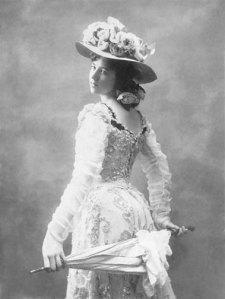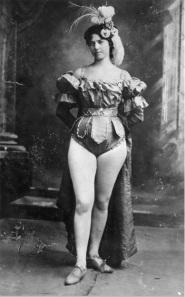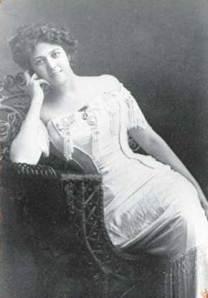I wouldn’t have known what I know now if I hadn’t lived the way I have. - Kathleen Rockwell
Though there have always been women who made a career of directly accepting money for sex, the majority of those who have taken money for it – perhaps as high as 90% of them – did so casually or infrequently, and never thought of themselves as whores per se. Indeed, it wasn’t until the 19th century that any woman who had ever done so was judged to be as “fallen” as those who made a career of it and eschewed marriage and domesticity. But like all new ideas, this one did not catch on everywhere right away; though it was popular in the “social purity” movement and later became the standard definition among American Progressives, many women of the transitional period continued to take money for sex on an irregular and unpredictable basis, leading to considerable controversy among both contemporary and modern bean-counters as to whether or not they were “really” prostitutes.
 Case in point: Kathleen Eloisa Rockwell, born in Junction City, Kansas, in 1873 (though she later claimed 1876). Her parents had both divorced their spouses to marry each other, then in turn divorced after a move to North Dakota. By the time Kate was five her mother Martha had again remarried to a wealthy businessman; until she was 15 she lived in a mansion in Spokane, Washington. But after her stepfather’s business failed the marriage did as well, and Martha dragged Kate off to Chile, where her son from her first marriage was living; on the voyage there Kate accepted a young officer’s proposal of marriage. Since Martha had entirely failed to grasp that “do as I say, not as I do” is an ineffective parenting strategy, she was aghast; she ended the engagement and upon arrival in Valparaiso enrolled Kate in a convent school. No sooner had she graduated and started teaching kindergarten than she accepted another proposal, this time from a Spanish diplomatic attaché; she soon ended that one at the insistence of the school’s principal. In later years, she claimed to have accepted over 100 proposals in her life, and broken all but a few of them; I suggest the reader view this as akin to courtesan’s claims of men committing suicide over them, or modern strippers’ staggering incomes that never seem to translate into actual bank balances.
Case in point: Kathleen Eloisa Rockwell, born in Junction City, Kansas, in 1873 (though she later claimed 1876). Her parents had both divorced their spouses to marry each other, then in turn divorced after a move to North Dakota. By the time Kate was five her mother Martha had again remarried to a wealthy businessman; until she was 15 she lived in a mansion in Spokane, Washington. But after her stepfather’s business failed the marriage did as well, and Martha dragged Kate off to Chile, where her son from her first marriage was living; on the voyage there Kate accepted a young officer’s proposal of marriage. Since Martha had entirely failed to grasp that “do as I say, not as I do” is an ineffective parenting strategy, she was aghast; she ended the engagement and upon arrival in Valparaiso enrolled Kate in a convent school. No sooner had she graduated and started teaching kindergarten than she accepted another proposal, this time from a Spanish diplomatic attaché; she soon ended that one at the insistence of the school’s principal. In later years, she claimed to have accepted over 100 proposals in her life, and broken all but a few of them; I suggest the reader view this as akin to courtesan’s claims of men committing suicide over them, or modern strippers’ staggering incomes that never seem to translate into actual bank balances.
Only three years after her arrival in Chile, Martha decided to return to New York; she soon asked Kate to join her there, but when she arrived in November of 1892(?) she found that her mother was both broke and too old to attract another rich husband. Kate supported them both with a number of chorus-girl gigs until an old friend invited her back to work in a vaudeville theater in Spokane; there she not only sang and danced, but also made a cut from drinks customers bought her (it seems likely that her first tricks were picked up there). When the Klondike gold rush started in the summer of 1897, Kate recognized it as a matchless opportunity; within a year she had put together the money to resettle her mother in Seattle and pay for passage to Canada. She arrived in Victoria, BC late in the autumn, and discovered that the RCMP would not let women go any farther because the winter was “too dangerous”. But like any good harlot, she refused to let the arbitrary declarations of cops deter her when there was money to be made; she therefore disguised herself as a boy and sneaked onto a cargo ship headed for Whitehorse, Yukon.
 She worked as a tap-dancer in Whitehorse for most of 1899, then joined the Savoy Theatrical Company when its new theater in Dawson opened in 1900. Since she stood out in looks, talent and sex appeal from the other girls she soon attracted the attention of Charlie Meadows, who offered her $200 a week (about $5500 today) and star billing at his Palace Grande Theater, where she immediately became a huge hit. Her show-stopper, the “Flame Dance”, included her twirling a huge swath of red chiffon about while singing and dancing; men threw money at her during the act, and she charged them to dance with her afterwards. She is also known to have charged for company, but was extremely discreet about it; altogether, she later estimated she made about $500 a week beyond her salary, a total of about $30,000 ($815,000 today) by the end of 1900. On Christmas Eve she was crowned “Queen of the Yukon” by her fans, and a miner named Johnny Matson (more on him later) fell instantly in love with her.
She worked as a tap-dancer in Whitehorse for most of 1899, then joined the Savoy Theatrical Company when its new theater in Dawson opened in 1900. Since she stood out in looks, talent and sex appeal from the other girls she soon attracted the attention of Charlie Meadows, who offered her $200 a week (about $5500 today) and star billing at his Palace Grande Theater, where she immediately became a huge hit. Her show-stopper, the “Flame Dance”, included her twirling a huge swath of red chiffon about while singing and dancing; men threw money at her during the act, and she charged them to dance with her afterwards. She is also known to have charged for company, but was extremely discreet about it; altogether, she later estimated she made about $500 a week beyond her salary, a total of about $30,000 ($815,000 today) by the end of 1900. On Christmas Eve she was crowned “Queen of the Yukon” by her fans, and a miner named Johnny Matson (more on him later) fell instantly in love with her.
Unfortunately, she had recently begun a relationship with an ambitious Greek immigrant named Alexander Pantages, a former boxer and current bartender with plans to open a chain of theaters. They opened the Orpheum together early in 1901, and with Kate as its headliner they were soon rolling in money. But in the spring of the following year, Pantages realized that the gold was running out and suggested the two of them move to Seattle; Kate did not wish to leave Dawson, so they embarked upon a long-distance relationship. Even after she finally came back to the US in 1903 or 1904, she wanted to tour while he was stuck in Seattle working on his dream of a theater chain. While she was performing in Texas, Alex took up with a violinist named Lois Medenhall, whom he married on March 12, 1905; though their relationship had clearly been cooling for a long time Kate was furious and filed a breach-of-promise lawsuit against him in May, seeking the return of the $60,000 she had invested in his theaters plus another $25,000 in damages. The affair upset her terribly, however, and she started drinking heavily; she settled out of court in April 1906 for a paltry $5,000, then moved to Fairbanks, Alaska, opened a hotel and performed at a nightclub called the Floradora. Luck was not with her; the uninsured hotel burned down in 1907 and she left Alaska flat broke.
 Since she was only 34, she easily built up another career in vaudeville. But there was not nearly as much money to be made in Seattle as there had been in the Klondike, and besides she was depressed and drinking; after a knee injury ended her dancing career for good in 1914 she had a nervous breakdown, and left Seattle to open a boarding house in Bend, Oregon (at which some of her boarders seem to have been whores). Though money was tight, she preferred to do most of the menial work herself rather than sell any of her expensive jewelry; as she later told a biographer, “I can remember the queer looks on the faces of customers, seeing me up to my elbows in soap suds, with a thousand dollars’ worth of diamonds in each ear.” She eventually built her business into a profitable enough venture to make large donations to the town’s volunteer fire department, but made the mistake of selling it in the early 1920s to start a restaurant in California…which promptly failed so badly she was forced to borrow money from the now-successful Alex Pantages. The latter’s fortune did not last long after that, however; in 1929 his wife Lois was tried for killing a man while driving drunk, and Alex was charged with raping a young actress. Though his conviction was overturned after two years in prison, he was financially ruined and died of a heart attack in 1936.
Since she was only 34, she easily built up another career in vaudeville. But there was not nearly as much money to be made in Seattle as there had been in the Klondike, and besides she was depressed and drinking; after a knee injury ended her dancing career for good in 1914 she had a nervous breakdown, and left Seattle to open a boarding house in Bend, Oregon (at which some of her boarders seem to have been whores). Though money was tight, she preferred to do most of the menial work herself rather than sell any of her expensive jewelry; as she later told a biographer, “I can remember the queer looks on the faces of customers, seeing me up to my elbows in soap suds, with a thousand dollars’ worth of diamonds in each ear.” She eventually built her business into a profitable enough venture to make large donations to the town’s volunteer fire department, but made the mistake of selling it in the early 1920s to start a restaurant in California…which promptly failed so badly she was forced to borrow money from the now-successful Alex Pantages. The latter’s fortune did not last long after that, however; in 1929 his wife Lois was tried for killing a man while driving drunk, and Alex was charged with raping a young actress. Though his conviction was overturned after two years in prison, he was financially ruined and died of a heart attack in 1936.
Kate married a cowboy named Floyd Warner in the late ‘20s, but that was over by the time she received a letter from Johnny Matson, who had never stopped loving her; he had read a newspaper account of the Pantages trial (during which Kate had been subpoenaed by the prosecution as a character witness) and decided to look her up again. In that letter he proposed, and she married him in Victoria, BC on July 14, 1933. He was still a miner and very solicitous of her welfare, so he insisted she spend the winters in Oregon rather than at his remote claim. During this time she began to be invited to appear at miner’s reunions in Portland, and spent her winters training young Hollywood actresses in vaudeville techniques. They lived happily this way until the winter of 1946, when she was notified that Matson had been found dead in the woods miles from his cabin. Two years later she married another old admirer, an Oregon accountant named W. L. Van Duren, and was still with him when she died at the age of 83 on February 21, 1957. Though she is not well-known in most of the US, she is still remembered fondly in Alaska and Oregon; in the former as the glamorous showgirl of her youth, and in the latter as the generous civic benefactress of her later years. And despite what moralists like to believe, they were one and the same woman.
